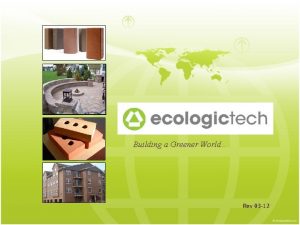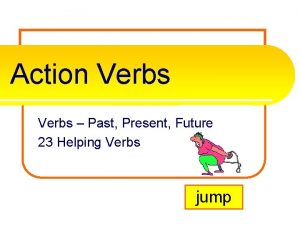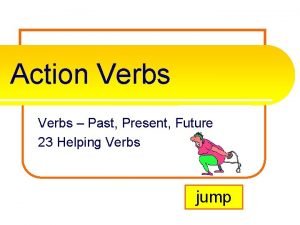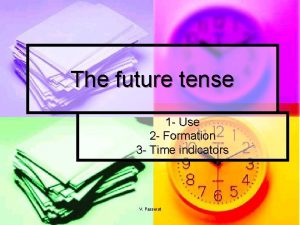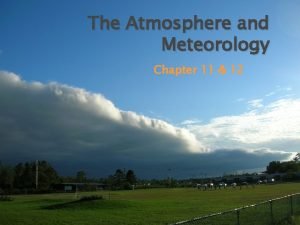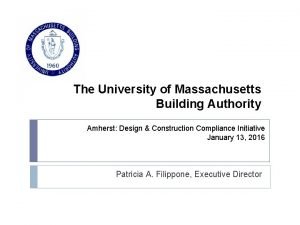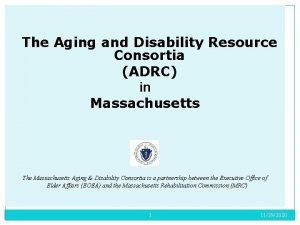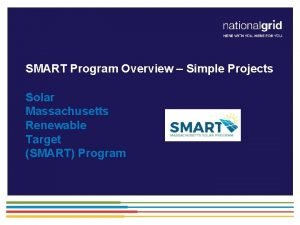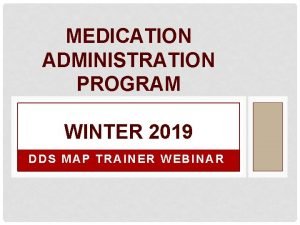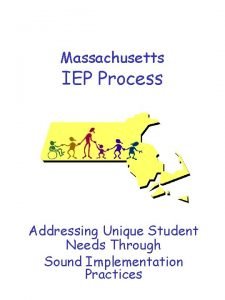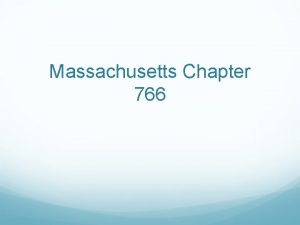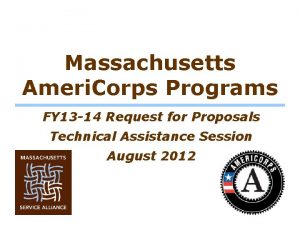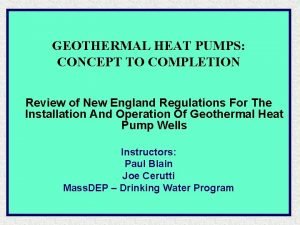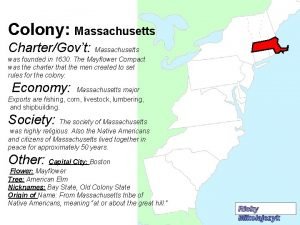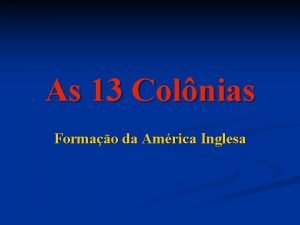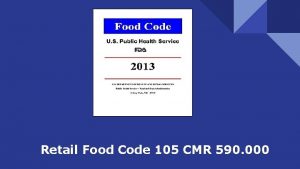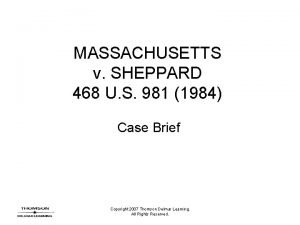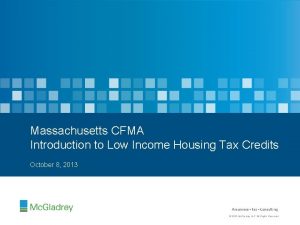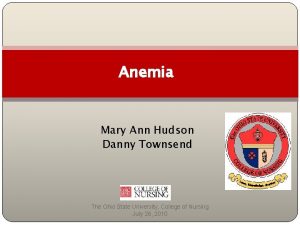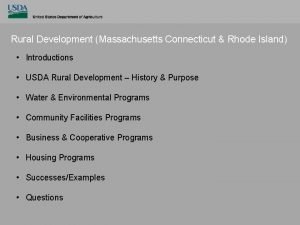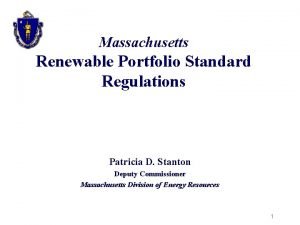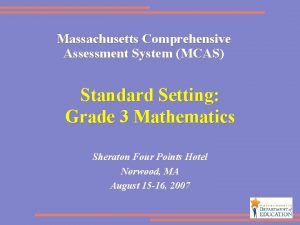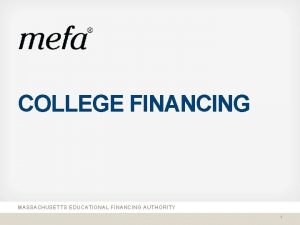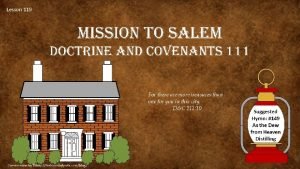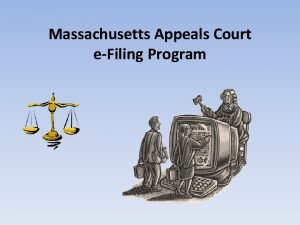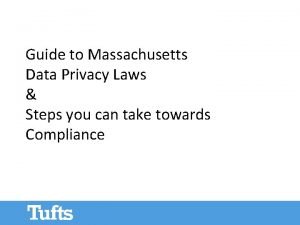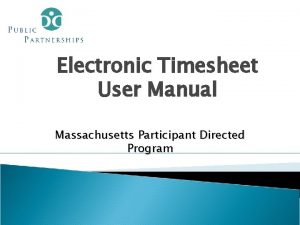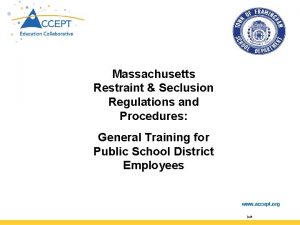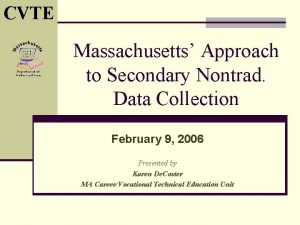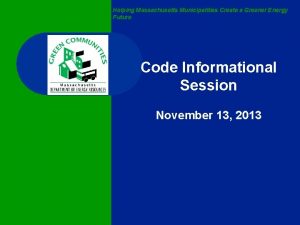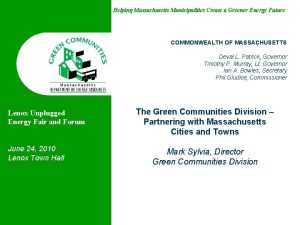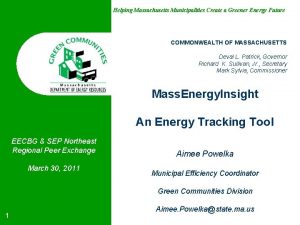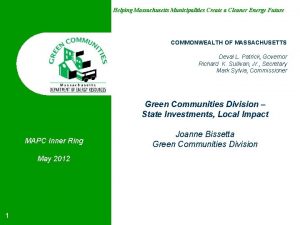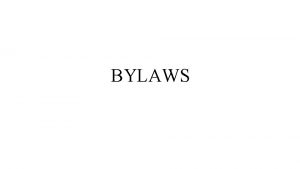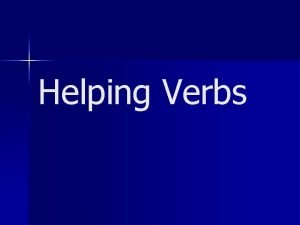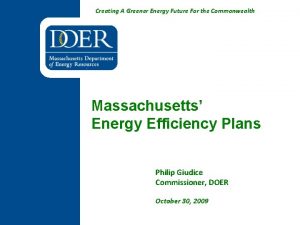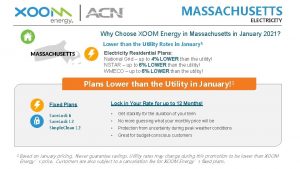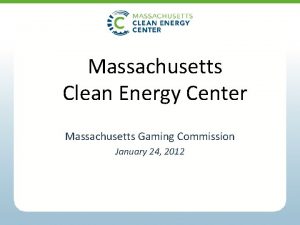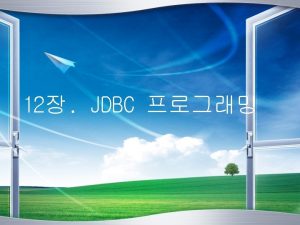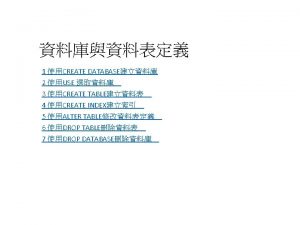Helping Massachusetts Municipalities Create a Greener Energy Future






































































- Slides: 70

Helping Massachusetts Municipalities Create a Greener Energy Future Code Informational Session February 10, 2016

Introduction to Energy Codes

Agenda What & Why? Changes Future

The wonderful world of Acronyms ASHRAE American Society of Heating, Refrigeration and Air-Conditioning Engineers ICC International Codes Council IECC International Energy Conservation Code IRC International Residential Code DOER Department of Energy Resources HERS Home Energy Rating DOE Department of Energy

IECC and ASHRAE Codes § ICC & ASHRAE develop model building codes and standards for the US. § ICC: publishes IECC energy code § § 3 year cycle IECC 2012, IECC 2015, IECC 2018 ASHRAE: publishes 90. 1 standard § 3 year cycle 90. 1 -2010, 90. 1 -2013

The World of Codes n n n 1980’s through 2006 n Minimum codes were truly minimal n DOE pushed for marginal improvements (1% to 3% per cycle) n DOE proposed (successfully) a major rewrite of the IECC in 2004 (became the 2006 IECC)—emphasis was format, not stringency 2009 to present n The world has changed ICC/DOE working from two goals n 30% improvement in 2012 IECC (relative to 2006) n 50% improvement in 2015 IECC (relative to 2006)

What in the world has changed? n n What is driving the changes to the code: n Public interest n Political will n Pull at ICC What in the world has changed? n More efficiency making it into codes n More detail/complexity being pushed onto code officials n More need for expertise and analysis tools in code process n Less distinction between code, beyond-code

Massachusetts Energy Code History n 6 th edition of the building code had a MA specific energy code n 7 th edition adopted IECC 2006 n n Commercial bldgs. ASHRAE 90. 1 -2004 8 th edition adopted IECC 2009 on July 1, 2010 n Roughly 10 -15% more efficient than IECC 2006 n Commercial bldgs. ASHRAE 90. 1 -2004 remains n Also in 2010 the edition of the “Stretch Code” appendix IECC 2012 was adopted on 7/1/2013 n Designed to be 30% better than IECC 2009 n Stretch Code IECC 2015 coming July 1, 2016 or at least by summer…

IECC 2015

Overview of the 2015 Energy Code As with IECC 2012, IECC 2015 requires a better envelope, insulation, ducts, windows, mechanical and more efficient lighting.

2015 IECC –Overview THE BIG CAVEAT n n Approximately 15% more efficient than the 2009 IECC Contains minor changes, very similar to IECC 2012, except for: Introduction of a new Energy Rating Index (ERI) compliance path Updated Existing Building Section that includes Renovations, Additions and Historic Building language: n Listed in the National Register n Eligible to be listed in the National Register

Structure of the IECC 2015 Ch. 1 and Ch. 2 Scope and Application / Administrative and Enforcement n Ch. 3 Climate zones and general materials requirements n n Ch. 4 Residential and Commercial Energy Efficiency Ch. 5 Existing Buildings n Ch. 6 Referenced Standards n

Minor Updates to Chapter 4 Building Envelope Provisions n n n The first change is a new exception to section ‘Access hatches and doors’. The exception allows vertical doors that provide access from conditioned to unconditioned spaces to meet the fenestration requirements (i. e. , U-value) in Table R 402. 1. 1. This change means that these types of doors, such as attic knee wall doors, do not have to be insulated the same way as the surrounding wall, as long as they meet the U-value requirements in the table.

Update to Chapter 4 n Another new exception allows for the floor framing cavity insulation to not be in contact with the underside of the subfloor decking as long as it is: n n n In contact with the top side of sheathing or continuous insulation installed on the bottom side of floor framing; And the all the perimeter band joists are insulated to the wood frame wall requirements. The next adds a new section to address ‘Walls with partial structural sheathing’ n Where continuous insulation is required and structural sheathing covers 40 percent or less of the total exterior wall area, the R-value of the continuous insulation may be reduced by an amount not to exceed R-3 in order to

Additional Updates to Chapter 4 n n The change allows dynamic glazing to satisfy the Solar Heat Gain Co-Efficient (SHGC) requirements where the ratio of the higher- to-lower labeled SHGC is greater than or equal to 2. 4, or where both the upper and lower labeled SHGC already comply with the requirements of the table. The most significant revision was made in chapter 4 was under ‘Air Barrier and Insulation Installation’ n n Splitting the ‘criteria’ column into separate ‘air barrier’ and ‘insulation installation’ criteria. Additionally new criteria for ‘concealed sprinklers’ was added along with revised criteria for ‘walls’, ‘floors’ and ‘fireplaces’.

“Ditto” Updates to Chapter 4 n Testing for building envelope air leakage as required under section 4 was also revised to require: n n That all testing be done in accordance with ASTM E 779 or ASTM E 1827. There is also a change to the duct insulation provisions n n The new language clarifies that both supply and return ducts in attics must be insulated to a minimum of R-8, where 3 inch or greater in diameter and R-6 where less than 3 inch diameter. Supply and return ducts located elsewhere in the building must be insulated to a minimum of R-6, where 3 inch or greater in diameter and R-4. 2 where less than 3 inch diameter.

And last, but not least… Two new appendices were approved: n n Procedures for worst-case (CAZ) testing of atmospheric venting systems Solar-ready provisions for detached one- and two-family dwellings. An appendix is not mandatory unless an adopting entity makes it such. After analyzing all the changes that were approved for the 2015 IECC, you will notice that the actual impact to energy efficiency is minor. The most significant changes to the new IECC residential provisions will be the addition of a new Energy Rating Index compliance path and a new chapter to address existing buildings.

Chapter 4 Residential Energy Code n n n Residential Provisions contains the energyefficiency-related requirements for the design and construction of residential building regulated under this code. The applicable portions of a residential building must comply with the provisions within this chapter for energy efficiency. The provisions within the chapter promote energy efficiency in the building envelope, the heating and cooling system and the service water heating system of the building.

Chapter 4 Commercial Energy Code n n n Commercial Provisions contains the energyefficiency-related requirements for the design and construction of most types of commercial buildings and residential buildings greater than three stories in height above grade. Residential buildings, townhouses and garden apartments three stories or less in height are covered in the IECC—Residential Provisions. The provisions within the chapter promote energy efficiency in the building envelope, the heating and cooling system and the service water heating system of the building.

Scope of Chapter 4 Same definitions, Different code n Defines Residential Buildings as: One- and two-family dwellings, townhouses of any size and R-2, R-3, R-4 ≤ 3 stories n All buildings that are not “residential” by definition are “commercial” n Includes additions, alterations, renovations and repairs Existing buildings Buildings designated as historic Very low energy use buildings [<3. 4 Btu/h-ft 2 or 1 watt/ft 2] n n

What stays the same from IECC 2012 Lighting stays at 75% of lamps must be ―high efficacy n Mandatory duct system pressure test n Mandatory infiltration testing n R-Values and U-Values the same n Retains IECC 2012 prohibition on envelope-equipment tradeoffs n

Scope Section R 101 Additions Treat as a stand-alone building n Additions must meet the prescriptive requirements in Table 402. 1. 1 (or U-factor or total UA alternatives) n Treat as new construction n

Existing Buildings-Additions, Alterations, Renovations, Repairs Code applies to any new construction n Unaltered portion(s) do not need to comply n Additions can comply alone or in combination with existing building n Replacement fenestration that includes both glazing and sash must meet n n U-factors in all Climate Zones 2 -8

Climate Zones for the 2015 IECC

Scope Section R 101 - Additions, Alterations, Renovations, Repairs. Exceptions n n n n n Storm windows over existing fenestration Glass-only replacements Exposed, existing ceiling, wall or floor cavities if already filled with insulation Where existing roof, wall or floor cavity isn’t exposed Reroofing for roofs where neither sheathing nor insulation exposed Insulate above or below the sheathing Roofs without insulation in the cavity Sheathing or insulation is exposed Lighting alterations if: n <50% of luminaries in a space are replaced n Only bulbs and ballasts within existing luminaries are replaced (provided installed interior lighting power isn’t increased)

Scope Section R 101 - Space Conditioning Any non-conditioned space that is altered to become conditioned space shall be required to be brought into full compliance with this code n Examples: n Converting a garage to a family room n Heating an unfinished n

Scope Section R 101 - Mixed Use Buildings-Know both codes! n Treat the residential occupancy under the applicable residential code n Treat the commercial occupancy under the commercial code

Overview of Code Structure Climate-Specific Requirements: n Roofs n Above grade walls n Foundations n Basements n Slabs n Crawlspaces n Skylights, windows, and doors Mandatory Requirements (apply everywhere): n n n n Infiltration control Duct insulation, sealing, and testing HVAC controls Piping Insulation Equipment sizing Dampers Lighting

Overview of IECC 2015 Residential Code Requirements Focus is still on: n n n n Building envelope ceilings, walls, windows, floors, foundations Sets insulation and fenestration levels, and solar heat gain coefficients Infiltration control - caulk and seal to prevent air leaks, and test Ducts, air handlers, filter boxes – seal, insulate, and test Limited space heating, air conditioning, and water heating requirements Federal law sets most equipment efficiency requirements, not the I-codes No appliance requirements Lighting equipment – 75% of lamps to be high-efficacy lamps or 75% of lighting fixtures to have only high-efficacy lamps

Compliance IECC Terminology n Prescriptive, UA/U-Factor and Performance n n n Energy Rating Index (ERI) compliance path Mandatory requirements n Required and cannot be traded down, even in the simulated performance path Some elements have “hard limits” aka, “trade-off limits” n a prescriptive requirement that can only be traded so far n performance requirements can only be traded so far

IECC 2012/2015 Compliance Three Options

Code Compliance Tools

IECC Comparison Typical Existing Home Std New Home IECC 2006 IECC 2012 ~ HERS 70 Stretch Code < 3000 sq ft - HERS 70 > 3000 sq ft - HERS 65 IECC 2015 ~ HERS 55

Performance Path Changes n A new performance path compliance option was approved Energy Rating Index (ERI) Compliance Alternative: n n This new ERI compliance path represents the most significant change coming to the IECC 2015. This new performance path option is based ERI RESNET’s Home Energy Rating System (HERS) is one of the most common systems that use an ERI.

Performance Path Changes Aside from meeting an ERI score between 51 and 55. n The path also requires some minimum mandatory requirements including building envelope levels at least as stringent as the IECC 2009. n A requirement that verification of compliance be completed by an approved third party. n

IECC 2012 Major Changes are still IECC 2015 Code n n Duct leakage rates lowered Domestic hot water piping must be either n Insulated to R 3, or n Short and skinny (i. e. , exempted lengths depend on diameter) Eliminated ―leakage to outdoors option for ducts n From 12 to 4 CFM/100 sf CFA (after construction) n From 6 to 4 CFM/100 sf CFA (at rough-in) Various R-value/U-factor/SHGC improvements

Same IECC Infiltration Rates n Mandatory wholehouse pressure test (blower door) with stringent required leakage rates Zones 3 -8: ≤ 3 ACH @50 Pa n Address fireplaces and recessed lighting fixtures n

Yup Air Tightness Requirements…Same n Compliance Just like the 2012 code, 2015 provides a lot of leeway to the local inspector; according to the code, “Where required by the code official, an approved third party shall inspect all components and verify compliance. ” n Reference Table R 402. 4. 1. 1 for requirements n n http: //publicecodes. cyberregs. com/icod/iecc/2012/i cod_iecc_2012_re 4_sec 002_par 027. htm

Building Envelope Specific Requirements Building Envelope consists of: n n n n n Fenestration Ceilings Walls Above grade Below grade Mass walls Floors Slabs Crawlspaces

IECC 2009/2012–Major Prescriptive Envelope Changes

IECC 2015–Insulation and Fenestration Rating Requirements

Insulation Verification n n R-values are to be printed on the batt insulation or rigid foam board. Blown-in insulation must have an insulation certificate at or near the opening of the attic. The certificate should include: n R-value of installed thickness n Initial installed thickness n Installed density n Settled thickness/settled R-value n Coverage area n Number of bags installed Insulation markers must be installed every 300 square feet and be marked with the minimum installed thickness and affixed to the trusses or joists.

Floors (Over Unconditioned Space) Unconditioned space includes unheated basement, vented crawlspace, or outdoor air Crawl Space Insulation Tips: • Insulating crawl spaces will help to air seal and control moisture. • How you insulate a crawl space depends on whether it's ventilated or unventilated. • Traditionally, crawl spaces are vented to Insulation must maintain prevent problems with moisture; most permanent contact with building codes require vents to aid in underside of subfloor-Climate removing moisture from the crawl space Zone 5 -R 30

Mandatory Requirements Mechanical Systems n n n Controls-At least one programmable thermostat/dwelling unit Heat pump supplementary heat Ducts n n n n n Sealing (Mandatory) Insulation (Prescriptive) HVAC piping insulation* Circulating hot water systems Ventilation Dampers Equipment sizing-Heating and cooling equipment shall be sized according to Manual S based on loads calculated according to Manual J Pools and in ground permanently installed spas Snow melt controls

Duct Sealing and Insulation Duct Sealing n Mandatory test 3 CFM ACH@50 n n Rough in and post construction tests Adopts testing widely used by Stretch Code / Energy Star Homes Not required if located within conditioned space Framing cavities cannot be used as ducts or plenums Duct Insulation n Supply ducts in attics: R-8 (Attic) n All other ducts: R-6 (Basement, Crawlspace, Exterior Wall, )

Lighting Equipment A minimum of 75% of the lamps in permanently installed lighting fixtures shall be high-efficacy lamps or 75% of permanently installed lighting fixtures to contain only high efficacy lamps. n “Lamps in fixtures” n Exception: n n Low-voltage lighting n Use specified lighting

High Efficacy Lighting and Compliance n The residential lighting provisions in the 2012 IECC are relatively simple. n At least 75% of the lamps in permanent light fixtures must be high-efficacy, defined as: n T 8 or smaller-diameter linear fluorescent lamps, n Or lamps such as CFLs, LEDs or Pin Based Lamps with a minimum efficacy of: n 40 lumens/W for <15 W n 50 lumens/W for 15 -40 W n 60 lumens/W for >40 W lamps

Ventilation The building shall be provided with ventilation that meets the requirements of the IRC, IMC, or other approved ventilation. n Minimum efficacy: n Range hoods 2. 8 cfm/watt n In-line fans 2. 8 cfm/watt n Bathroom fan (10 -89 cfm) 1. 4 cfm/watt n Bathroom fan (90+ cfm) 2. 8 cfm/watt n

What about mechanical ventilation? n The 2015 IECC continues to include provisions to improve a home’s air tightness, it provides little on whole house ventilation. n A typical home will require about 15 cfm person of fresh outdoor air to be distributed by continuous mechanical ventilation to meet the requirements of the code. n The new code requires homes in zone 5 achieve 3 ach 50, the code effectively mandates a whole-house mechanical ventilation system. n This can be accomplished with a centrally located quiet exhaust fan, an interconnected system to the air handler, HRV/ERV or a combination of devices.

Eave Baffles n n n For air permeable insulations in vented attics, baffle Installed adjacent to soffit and eave vents To maintain an opening ≥ size of vent To extend over top of attic insulation May be of any solid material

RESIDENTIAL INCENTIVES n Almost the same as the Stretch Code/IECC 2012 n n Builder incentives/rebates n n n $750 - $7000 for SFD $350 - $4, 000 for MF HERS raters n n n Approx 30% of new homes in MA $700 - $900 SFD $250 - $550 MF Additional Equipment Rebates n n n Appliances – up to $50 (low income) Massachusetts Residential New Heating – up to $1, 500 Construction Program Water Heating – up to $800 Cooling – up to $500 Lighting – free CFLs

IECC 2015 Bottom Line Code Compliance Just like IECC 2012 every new home built will need to be tested with a blower door, have a strategy to stop thermal bridging, need a tighter envelope, tighter ducts, right sized mechanical systems, more efficient lighting and mechanical ventilation.

Stretch Code Appendix 120. aa

What is the Stretch Code? Affects the energy code only n Amendment to the MA base energy code n n Residential Construction: n n Commercial: n n 15 -20% more energy efficient The Stretch Code is similar to the 2012 IECC

Misconceptions n n n The Stretch Code is new and experimental The Stretch Code requires tight unhealthy homes The Stretch Code requires foam insulation The Stretch Code requires mechanical ventilation Homes with oil heat cannot meet the Stretch Code Town residents will be required to update their existing homes

What does the Stretch Code Apply to? n Same application as the MA base energy code n Insulation n Doors, Windows, Skylights n Mechanical Equipment n Lighting n Appliances n Building tightness n Duct tightness n Renewables

Code Compliance Requirements


What does the Stretch Code Apply to? n Residential Additions n Home Renovations n New Construction n n Commercial (5, 000+sq/ft) New Construction n Additions n Renovations Exempt n

Additions and Renovations Prescriptive or Performance Path n Prescriptive Path n n ENERGY STAR Windows, Doors and Skylights Tight Ducts – completely new duct systems only Contractor Verified Thermal Bypass Checklist Performance Path n Whole house HERS Rating n Renovations: n n HERS 85 < 2, 000 sq ft. HERS 80 ≥ 2, 000 sq ft. n Additions: n n HERS 70 < 3, 000 sq ft. HERS 65 ≥ 3, 000 sq ft.

New Homes Performance Path n Performance is the only option n HERS 70 < 3, 000 sq ft. HERS 65 ≥ 3, 000 sq ft. HERS Rating Company n n n Review building plans Thermal bypass Checklist Blower-door and duct testing

New Homes Performance Path n Home Energy Rating System (HERS) Index n n n Internal Revenue Service U. S. Department of Energy U. S. Environmental Protection Agency Mortgage Industry Massachusetts Base Code - Alternative Path Mass Save Residential New Construction Program

New Homes Performance Path n Governed by the Residential Energy Services Network (RESNET) n n n Technical Standards Testing Procedures Quality Assurance Continuing Education Code of Ethics Complaint Resolution

Cost of the Stretch Code Housetype Size Upgrade Costs Add’l Annual Mortgage Annual Savings Single Family 2, 672 $2, 949 $214 $507 w/ incentives 2, 672 $1, 755 $127 $516 Single Family 4, 462 $6, 476 $471 $1, 455 w/ incentives 4. 462 $5, 176 $376 $1, 455 Single Family 1, 708 $4, 162 $302 $583 w/ incentives 1, 708 $3, 243 $236 $595

COMMERCIAL STRETCH CODE

Commercial ‘Stretch’ Appendix New buildings and additions over 5, 000 ft 2, renovations fall to the base code n Two Options (depending on size) n n Performance option - 20% below ASHRAE Code n Prescriptive option for most building types n 5, 000 - 100, 000 ft 2 n Special Code Exemptions (comply with base code) for laboratories, manufacturing, etc. 66

Stretch Code Compliance & Inspections n Same as base code n Code Official has the same authority n Same building inspections n Approves building documents

Future of the Stretch Code n The MA base energy code will update this year n The Stretch Code will update too n More energy efficient n No details yet n Automatic Adoption

Training on new energy codes n n Covering both the IECC 2012, 2015 & Stretch code Provided to Builders, Code Officials and trade organizations Utilities offer commercial ‘Core Performance’ energy training http: //www. masssave. co m/professionals/massach usetts-energy-codetechnical-support

Questions?
 Building a greener world
Building a greener world Helping verbs 23
Helping verbs 23 South cotabato municipalities
South cotabato municipalities Standing conference of towns and municipalities
Standing conference of towns and municipalities Future continuous and future perfect
Future continuous and future perfect Future perfect simple continuous
Future perfect simple continuous 23 helping verbs song
23 helping verbs song Future tense chart in english
Future tense chart in english 617-650-3557
617-650-3557 Jika noel(create(q)) adalah 0, maka front(create(q)) adalah
Jika noel(create(q)) adalah 0, maka front(create(q)) adalah The future is ours to create
The future is ours to create Lincoln the best way to predict the future is to create it
Lincoln the best way to predict the future is to create it Energy energy transfer and general energy analysis
Energy energy transfer and general energy analysis Energy energy transfer and general energy analysis
Energy energy transfer and general energy analysis In orographic lifting clouds form when moist winds
In orographic lifting clouds form when moist winds Perfect future
Perfect future Past future tense
Past future tense Future continuous future perfect exercises
Future continuous future perfect exercises Future nurse future midwife
Future nurse future midwife Future tense
Future tense Present progressive of plan
Present progressive of plan Summary of past and present
Summary of past and present Future plans and finished future actions
Future plans and finished future actions Perfect future continuous tense
Perfect future continuous tense 1 2 3 kondicional u engleskom jeziku
1 2 3 kondicional u engleskom jeziku Landmarks in boston
Landmarks in boston University of massachusetts building authority
University of massachusetts building authority Adrc massachusetts
Adrc massachusetts Ma smart program overview
Ma smart program overview Massachusetts
Massachusetts Hdmaster map
Hdmaster map Sample iep for 4 year old
Sample iep for 4 year old Massachusetts higher education consortium
Massachusetts higher education consortium Chapter 766 massachusetts law
Chapter 766 massachusetts law Timeline of concept paper
Timeline of concept paper Mcas pearson access next
Mcas pearson access next Closed loop geothermal well massachusetts
Closed loop geothermal well massachusetts Mayflower compact image
Mayflower compact image Província da baía de massachusetts
Província da baía de massachusetts Massachusetts food code
Massachusetts food code Massachusetts v sheppard
Massachusetts v sheppard Project impact massachusetts
Project impact massachusetts Massachusetts department of motor vehicle
Massachusetts department of motor vehicle Cfma massachusetts
Cfma massachusetts Mandated reporter training massachusetts
Mandated reporter training massachusetts Massachusetts work based learning plan
Massachusetts work based learning plan Danny townsend massachusetts
Danny townsend massachusetts Usda rural areas in massachusetts
Usda rural areas in massachusetts Massachusetts bay colony
Massachusetts bay colony Massachusetts renewable portfolio standard
Massachusetts renewable portfolio standard Body: massachusetts comprehensive assessment system
Body: massachusetts comprehensive assessment system Thomas barnard sermon massachusetts 1763
Thomas barnard sermon massachusetts 1763 Massachusetts educational financing authority
Massachusetts educational financing authority Child poverty in massachusetts
Child poverty in massachusetts Joseph smith salem massachusetts
Joseph smith salem massachusetts Hdap insurance
Hdap insurance Massachusetts association for professional law enforcement
Massachusetts association for professional law enforcement From massachusetts
From massachusetts Marlene sallo
Marlene sallo Efile massachusetts appeals court
Efile massachusetts appeals court Dsrip massachusetts
Dsrip massachusetts Data privacy massachusetts
Data privacy massachusetts Massachusetts timesheet
Massachusetts timesheet Depth map
Depth map Medication administration program massachusetts
Medication administration program massachusetts Restraint training massachusetts
Restraint training massachusetts Massachusetts office of travel & tourism
Massachusetts office of travel & tourism Cvte massachusetts
Cvte massachusetts Hcsis massachusetts
Hcsis massachusetts Dominant religious group in massachusetts bay
Dominant religious group in massachusetts bay Energy future lines solar panelsstoragebatteries
Energy future lines solar panelsstoragebatteries
